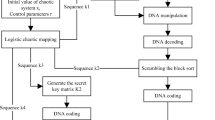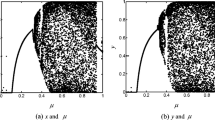Abstract
This paper presents a digital image encryption scheme based on multi chaotic system and random DNA coding. Firstly, the initial values and parameter values of 2D Logistic-adjusted-Sine mapping (2D-LASM) and Logistic-Sine system (LSS) are obtained from SHA256 hash values of the original image. In the scrambling stage, the chaotic sequences generated by 2D-LASM are used to get two column scrambling matrices and row scrambling matrix, respectively. The elements of the second column scrambling matrix and row scrambling matrix are used as row and column coordinates in the scrambling process. Then apply it to scrambling the DNA encoded image, which can complete the row and column scrambling at the same time. In the diffusion stage, we proposed a new diffusion method. Through the chaotic sequence generated by the LSS, a DNA coding sequence is obtained. DNA XOR operation is carried out on the central point and horizontal line of the image, and then spread from the central line to the upper and lower directions of the matrix to achieve the purpose of multi-directional diffusion and improve the encryption efficiency. Experimental results and security analysis show that the algorithm executes fast and has strong security. It can resist many attacks, such as statistical attacks, brute attacks, plaintext / select plaintext attacks, etc.












Similar content being viewed by others
Data availability
The images used to support the findings of this study are included within the article.
References
Alvrez G, Li S (2006) Some basic cryptographic requirements for chaos-based cryptosystems[J]. Int J Bifur Chaos 16(8):2129–2151
Behnia S, Akhshani A, Mahmodi H, Akhavan A (2008) A novel algorithm for image encryption based on mixture of chaotic maps[J]. Chaos, Solitons Fractals 35(2):408–419
Cao C, Sun K, Liu W (2018) A novel bit-level image encryption algorithm based on 2D-LICM hyperchaotic map[J]. Signal Process 143:122–133
Dagadu JC, Li J-P, Addo PC (2019) An image cryptosystem based on pseudorandomly enhanced chaotic DNA and random permutation[J]. Multimed Tools Appl 78(17):24979–25000
Deng X, Liao C, Zhu C, Chen Z (2014) Image encryption algorithms based on chaos through dual scrambling of pixel position and bit [J]. Journal on Communications 35(3):216–223 (Chinese)
Gao TG, Chen Z (2008) A new image encryption algorithm based on hyper-chaos[J]. Phys Lett A 372(4):394–400
Hua Z, Zhou Y (2016) Image encryption using 2D Logistic-adjusted-Sine map[J]. Inf Sci 339:237–253
Huang CK, Nien HH (2009) Multi chaotic systems based pixel shuffle for image encryption[J]. Opt Commun 282(11):2123–2127
Liu H, Wang X, Kadir A (2012) Image encryption using DNA complementary rule and chaotic maps[J]. Appl Soft Comput 1212(5):1457–1466
Matthews R (1989) On the derivation of a chaotic encryption algorithm[J]. Cryptologia 8(1):29–42
Nestor T, Dieu NJD, Jacques K et al (2019) A multidimensional Hyperjerk oscillator: dynamics analysis, analogue and embedded systems implementation, and its application as a cryptosystem [J]. Sensors 20(1):83
Pak C, An K, Jang P et al (2018) A novel bit-level color image encryption using improved 1D chaotic map[J]. Multimed Tools Appl 78(9):12027–12042
Ran T, Yi X, Yue W (2007) Double image encryption based on random phase encoding in the fractional Fourier domain[J]. Opt Express 15(24):16067–16079
Shen J, Jin X, Zhou C (2005) A color image encryption algorithm based on magic cube transformation and modular arithmetic operation[C]. In: Conference on advances in multimedia information processing-pcm. Springer-Verlag
Souyah A, Faraoun KM (2016) A review on different image encryption approach[C]. In: 4th international symposium on modelling and implementation of complex systems (MISC). Lecture notes in networks and systems, pp 3–18
TSafack N, Kengne J, Abd-El-Atty B et al (2020) Design and implementation of a simple dynamical 4-D chaotic circuit with applications in image encryption[J]. Inf Sci 515:191–217
Wang Y, Wong K-W, Liao X, Chen G (2011) A new chaos-based fast encryption algorithm[J]. Appl Soft Comput 11(1):514–522
Wang X-Y, Zhang Y-Q, Bao X-M (2015) A novel chaotic image encryption scheme using DNA sequence operations[J]. Opt Lasers Eng 73:53–61
Wang X, Yu W, Zhu X, Unar S (2019) Image encryption scheme based on chaos and DNA plain operations[J]. Multimed Tools Appl 78(18):26111–26128
Watson JD, Crick FHC (2003) Molecular structure of nucleic acids[J]. Am J Psychiatr 160(4):623–624
Wu Y, Yang G, Jin H, Noonan JP (2012) Image encryption using two-dimensional logistic chaotic map[J]. Journal of Electronic Imaging 21(1):013014
Yang J, Hao W (2018) Color image encryption algorithm based on chaotic system and dynamic DNA coding and operation[J]. Comput Eng 44(2):151–157 (Chinese)
Yang FF, Mou J, Cao YH, Chu R (2020) An image encryption algorithm based on BP neural network and hyperchaotic system[J]. China Communications 17(5):21–28
Zhou N, Zhang A, Zheng F, Gong L (2014) Novel image compression-encryption hybrid algorithm based on key-controlled measurement matrix in compressive sensing[J]. Opt Laser Technol 62:152–160
Zhou Y, Bao L, Chen CLC (2014) A new 1D chaotic system for image encryption[J]. Signal Process 97:172–182
Acknowledgements
This work is supported by the National Natural Science Foundation of China (Grant No. 61876201).
Author information
Authors and Affiliations
Corresponding author
Ethics declarations
Conflicts and interest
The authors declare that there are no conflicts and interest regarding the publication of this paper.
Additional information
Publisher’s note
Springer Nature remains neutral with regard to jurisdictional claims in published maps and institutional affiliations.
Rights and permissions
About this article
Cite this article
Zheng, J., Luo, Z. & Zeng, Q. An efficient image encryption algorithm based on multi chaotic system and random DAN coding. Multimed Tools Appl 79, 29901–29921 (2020). https://doi.org/10.1007/s11042-020-09454-9
Received:
Revised:
Accepted:
Published:
Issue Date:
DOI: https://doi.org/10.1007/s11042-020-09454-9




